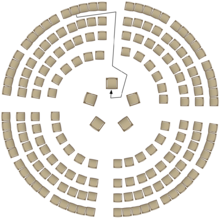Fishbowl (discussion method)
Fishbowl (also called the inner / outer circle method ) is a method of leading discussions in large groups . The method got its name from the seating arrangement: It is like a goldfish bowl around which the participants sit in a circle.
Process of a fishbowl
With the fishbowl method, a small group of participants discuss the topic in the inner circle (in the "goldfish bowl"), while the other participants observe the discussion in an outer circle.
If a participant from the outside circle would like to contribute to the discussion, there are different forms:
In the “guest chair” method, there is a free chair in the inner circle. A participant from the outer circle can take a seat on it and join the discussion until he has said everything or until another participant from the outer circle wants to take a seat on the guest chair. Or a participant from the inner circle can free up his place to enable a participant from the outer circle to work in the inner circle.
In another form of the method, participants from the outer circle can "tap off" a member of the inner circle. They can then finish their sentence and then make their place free for the participants from the outer circle. This form requires a high level of attentiveness and social skills on the part of the participants, because everyone has to control the process equally.
Often the process is supported by a moderator. The work of the inner circle can be discussed with the whole group at the end.
regulate
- The free chair in the discussion group can be occupied by each participant until he has made his or her contribution or another participant wants to make a contribution.
- Participants in the inner circle may leave this at any time.
- Side conversations are to be avoided.
Advantages over plenary discussions
As with the panel discussion , the discussion round is manageable, since only a small number of participants can discuss at a time. In this way, topics are focused and condensed.
The advantage of the fishbowl method is that members who otherwise do not have a say in a large group can switch to the inner circle at any time and express their opinion and actively participate in the discussion. This and the seating arrangements in the circle create a high level of identification among all participants with the work on the topic. A participant who does not feel like actively participating in the discussion can simply get out and listen from the outside. This keeps the discussion active and does not get lost in dead ends.
The method offers participants of different strengths more balanced opportunities to contribute their experiences and ideas. Helpful and hindering dominance relationships become visible through the change of place.
A group dynamic mirror effect can also be observed in the inner circle: Topics in the outer circle are treated “intuitively” in the inner circle, so to speak - even if no representative of the outer circle changes to the inner circle.
Web links
( Page no longer available , search in web archives: presentation of the method )
